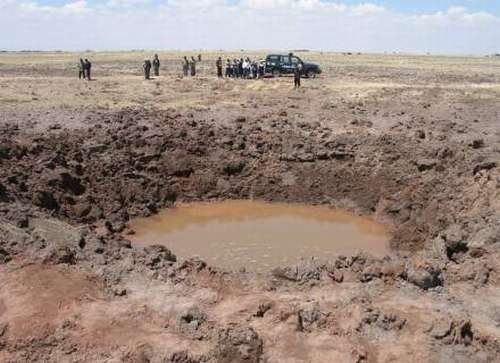Meteor Crash in Peru Caused Mysterious Illness
An object that struck the high plains of Peru on Saturday, causing a mysterious illness among local residents, was a rare kind of meteorite, scientists announced today.
A team of Peruvian researchers confirmed the origins of the object, which crashed near Lake Titicaca, after taking samples to a lab in the capital city of Lima
Nearby residents who visited the impact crater complained of headaches and nausea, spurring speculation that the explosion was a subterranean geyser eruption or a release of noxious gas from decayed matter underground.
But the illness was the result of inhaling arsenic fumes, according to Luisa Macedo, a researcher for Peru's Mining, Metallurgy, and Geology Institute (INGEMMET), who visited the crash site.
The meteorite created the gases when the object's hot surface met an underground water supply tainted with arsenic, the scientists said.
Numerous arsenic deposits have been found in the subsoils of southern Peru, explained Modesto Montoya, a nuclear physicist who collaborated with the team. The naturally formed deposits contaminate local drinking water.
"If the meteorite arrives incandescent and at a high temperature because of friction in the atmosphere, hitting water can create a column of steam," added José Ishitsuka, an astronomer at the Peruvian Geophysics Institute, who analyzed the object.
By Wednesday, according to Macedo, all 30 residents who felt ill reported feeling better.
"People Were Extremely Scared"
Locals described the meteorite as a bright, fiery ball with a smoke trail. The sound and smell rattled residents to the point that they feared for their lives, Ishitsuka said.
The meteorite's impact sent debris flying up to 820 feet (250 meters) away, with some material landing on the roof of the nearest home 390 feet (120 meters) from the crater, Ishitsuka reported.
"Imagine the magnitude of the impact," he said. "People were extremely scared. It was a psychological thing."
"They were in the epicenter of a small earthquake," Montoya, the nuclear physicist, said.
The resulting crater resembles a muddy pond measuring 42 feet (13 meters) wide and 10 feet (3 meters) deep.
Solving the Mystery
Even as meteorite samples arrived in Lima Thursday for testing, Peruvian scientists seemed to unanimously agree that it was a meteorite that had struck their territory.
"Based on the first-hand reports, the impact and the samples, this is a meteorite," Macedo, of INGEMMET, said.
Tests revealed no unusual radiation at the site, though its absence didn't rule out a meteorite crash.
"Everything has radioactivity, even underground rocks," Montoya said. "But nothing out of the ordinary was found."
Preliminary analysis by Macedo's institute revealed no metal fragments, indicating a rare rock meteorite. Metal stands up better to the heat created as objects enter Earth's atmosphere, which is why most meteorites are metallic.
The samples she reviewed had smooth, eroded edges, Macedo added.
"As the rock enters the atmosphere, it gets smoothed out," she said.
The samples also had a significant amount of magnetic material "characteristic of meteorites," she said.
"The samples stick to the magnet," Ishitsuka, the astronomer, confirmed. "That shows that there is iron present."
Water samples at the crater proved normal, but the color and composition of soil were "unusual" for the area, Macedo noted.
José Machare, a geoscience adviser at INGEMMET, said x-ray tests conducted on the samples earlier today further confirmed the object's celestial origins.
He said the group's findings put to rest earlier theories that the object was a piece of space junk or that the crater had formed by an underground explosion.
"It's a rocky fragment," Machare said, "and rocks that fall from the sky can only be meteorites."


